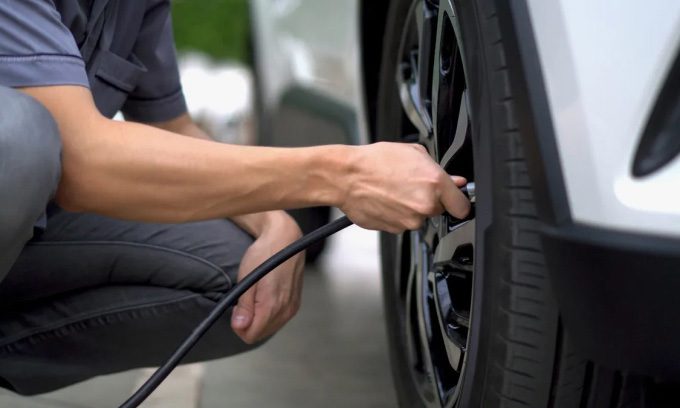Inflatable tires were invented in the 1800s and remain prevalent today, despite the need for regular inflation and occasional flats or blowouts.
Inflatable tires have several disadvantages. They can be overinflated in the summer, underinflated in the winter, or unexpectedly blow out on the highway. So why does the world still use inflatable tires today?
The first patent for an inflatable tire was granted in England in 1845, to inventor Robert William Thomson from Middlesex, England. “In every part of the rotation, the wheels will create an air cushion on the ground, tracks, or other types of roads they run on,” he described his design.

Inflatable tires are widely used. (Photo: BaLL LunLa).
“I have invented or discovered a new and useful improvement for horse-drawn vehicles, which can also be applied to other rolling objects,” Thomson added. He noted that adding an elastic cushion around the wheel reduces the effort needed to pull the vehicle, making it move more easily and decreasing the noise produced while running.
This invention emerged long before the advent of synthetic rubber, which now makes up the majority of rubber used in the tire industry. Therefore, Thomson recommended using vulcanized rubber or gutta-percha before inflation.
This was a groundbreaking invention: easy to make, low-cost, and capable of bringing significant improvements to daily life. However, it is strange that it did not further develop for many decades and required another inventor to truly make inflatable tires popular.
John Boyd Dunlop was a Scottish veterinarian who moved to Belfast, Northern Ireland. In 1888, inspired by seeing his son struggling to pedal a tricycle on a gravel road, he was motivated to invent – or rather, reinvent – the inflatable tire to ease the boy’s discomfort.
<pSimilarly to Thomson, his design utilized rubber treated with sulfur – a method developed by Charles Goodyear in 1844, now known as vulcanization. However, the difference was that Dunlop’s tires quickly became successful.
First, he actually manufactured and sold them, which is very beneficial for commercial success.
Second, he was also fortunate. “The bicycle boom peaked when Irish cycling champion Willie Hume bought a set of Dunlop tires for his bike the following year,” author Suze Clemitson explains in her book *A History of Cycling in 100 Objects*, published in 2017. Hume became the first cyclist to use inflatable tires in competition, and it is said that riding on these tires led to his victory.
The clear advantages of inflatable tires over the previous solid tires were increased speed and comfort. So why was air chosen for inflation?
As a gas, air can compress more than any solid material – which is crucial when only four wheels are bearing the weight of a vehicle that can be as heavy as 1,600 kg. Even lighter vehicles like bicycles certainly cause the tires to deform slightly – which is beneficial as it increases the tire’s contact area with the ground, providing more traction for the vehicle – and with inflatable tires, this requires much less energy than solid tires. This is why those who first used Dunlop’s tires could cycle much faster than their competitors. Inflatable tires make vehicles easier to maneuver at higher speeds while consuming less energy.
In physics, this is referred to as “rolling resistance”: the energy that tires consume over a unit distance traveled. Simply put, lower rolling resistance is better, and inflatable tires have an advantage over solid tires. This is not only due to their pliability but also because air is lighter than solid rubber. With the same deformation, heavier objects generate more heat, and that heat loss leads to higher rolling resistance.
All these advantages become even more apparent when a driver speeds down the road at nearly 100 km/h and suddenly encounters a pothole. At that speed, a sharp obstacle that appears suddenly will cause a severe jolt to solid tires – which can only absorb local shocks. In contrast, air will dissipate the impact across the entire tire, resulting in a smoother ride.




















































